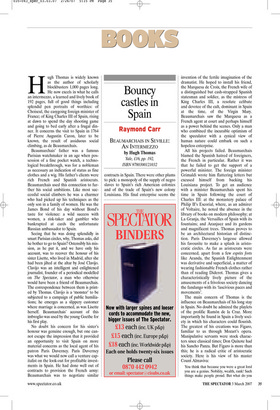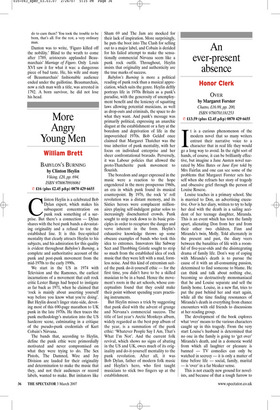Bouncy castles in Spain
Raymond Carr
BEAUMARCHAIS IN SEVILLE: AN INTERMEZZO by Hugh Thomas Yale, £16, pp. 192, ISBN 9780300121032 Hugh Thomas is widely known as the author of scholarly blockbusters 1,000 pages long. He now excels in what he calls an intermezzo, a learned and lively book of 192 pages, full of good things including splendid pen portraits of worthies: of Choiseul, the easygoing foreign minister of France; of King Charles III of Spain, rising at dawn to spend the day shooting game and going to bed early after a frugal dinner. It concerns the visit to Spain in 1764 of Pierre Augustin Caron, later to be known, the result of assiduous social climbing, as de Beaumarchais.
Beaumarchais’ father was a famous Parisian watchmaker in an age when possession of a fine pocket watch, a technological breakthrough, was for a nobleman as necessary an indication of status as fine clothes and a wig. His father’s clients were rich French and Spanish aristocrats. Beaumarchais used this connection to further his social ambitions. Like most successful social climbers he was a charmer who had picked up his techniques as the only son in a family of women. He was the James Bond of his day without Bond’s taste for violence: a wild success with women, a risk-taker and gambler who bankrupted at cards the unfortunate Russian ambassador to Spain.
Seeing that he was doing splendidly in smart Parisian circles, why, Thomas asks, did he bother to go to Spain? Ostensibly his mission, as he put it, and we have only his account, was to recover the honour of his sister Lisette, who lived in Madrid, after she had been jilted at the altar by José Clavijo. Clavijo was an intelligent and enlightened journalist, founder of a periodical modelled on The Spectator, a man who otherwise would have been a friend of Beaumarchais. The correspondence between them is printed by Thomas. Clavijo is a ‘monster’ to be subjected to a campaign of public humiliations; he emerges as a slippery customer where marriage is concerned, as was Lisette herself. Beaumarchais’ account of this imbroglio was used by the young Goethe for his first play.
No doubt his concern for his sister’s honour was genuine enough, but one cannot escape the impression that it provided an opportunity to visit Spain on more material concerns as the local agent of his patron Paris Duverney. Paris Duverney was what we would now call a venture capitalist on the look-out for profitable investments in Spain. He had done well out of contracts to provision the French army: Beaumarchais was to negotiate similar contracts in Spain. There were other plums to pick: a monopoly of the supply of negro slaves to Spain’s rich American colonies and of the trade of Spain’s new colony Louisiana. His final enterprise seems the invention of the fertile imagination of the dramatist. He hoped to install his friend, the Marquesa de Croix, the French wife of a distinguished but cash-strapped Spanish statesman and soldier, as the mistress of King Charles III, a resolute celibate and devotee of the cult, dominant in Spain at the time, of the Virgin Mary. Beaumarchais saw the Marquesa as a French agent at court and perhaps himself as a power behind the scenes. Only a man who combined the incurable optimism of the speculator with a cynical view of human nature could embark on such a hopeless enterprise.
All his projects failed. Beaumarchais blamed the Spanish hatred of foreigners, the French in particular. Rather it was that he failed to get the support of a powerful minister. The foreign minister Grimaldi wrote him flattering letters but excused himself from backing his Louisiana project. To get an audience with a minister Beaumarchais spent his time in Spain following the court of Charles III: at the monastery palace of Philip II’s Escorial, where, as an admirer of Voltaire, he noted the absence in the library of books on modern philosophy; at La Granja, the Versailles of Spain with its fountains; and Aranjuez and its gardens and magnificent trees. Thomas proves to be an architectural historian of distinction. Paris Duverney’s largesse allowed his favourite to make a splash in aristocratic circles. As far as aristocrats were concerned, apart from a few esprits forts like Aranda, the Spanish Enlightenment was derivative and superficial, a matter of wearing fashionable French clothes rather than of reading Diderot. Thomas gives a characteristically lively picture of the amusements of a frivolous society dancing the fandango with its ‘lascivious paces and movements’.
The main concern of Thomas is the influence on Beaumarchais of his long stay in Spain. No doubt he admired the playlets of the prolific Ramón de la Cruz. More importantly he found in Spain a lively society in which his characters could flourish. The greatest of his creations was Figaro, familiar to us through Mozart’s opera. Manipulative servants were stock characters since classical times; Don Quixote had his Sancho Panza. But Figaro is more than this; he is a radical critic of aristocratic society. Here is his view of his master Count Almaviva:
You think that because you were a great lord you are a genius. Nobility, wealth, rank! Such things make people proud. But what do you do to earn them? You took the trouble to be born, that’s all. For the rest, a very ordinary man.
Danton was to write, ‘Figaro killed off the nobility.’ Blind to the wrath to come after 1789, aristocrats applauded Beaumarchais’ Marriage of Figaro. Only Louis XVI saw it for what it was: a dangerous piece of bad taste. He, his wife and many of Beaumarchais’ fashionable audience ended under the guillotine. Beaumarchais, now a rich man with a title, was arrested in 1792. A born survivor, he did not lose his head.











































































 Previous page
Previous page